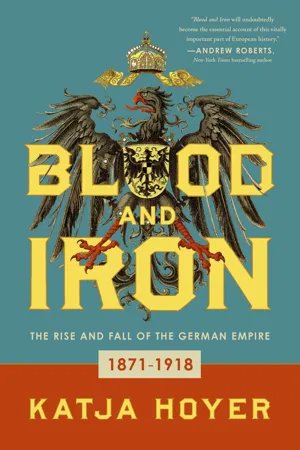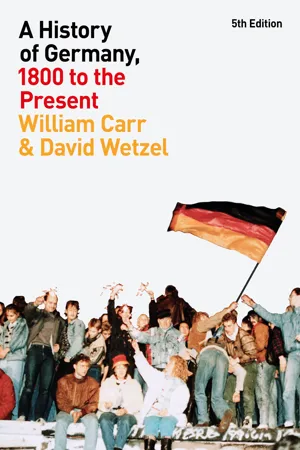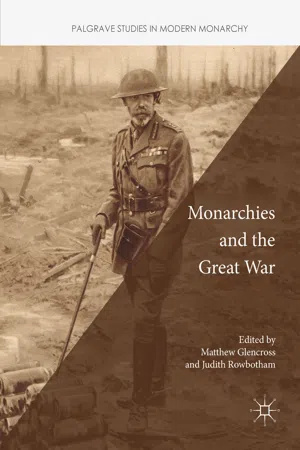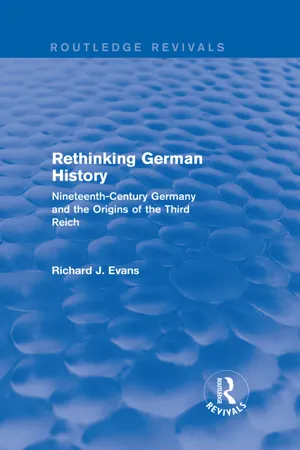History
Wilhelm I
Wilhelm I, also known as Wilhelm Friedrich Ludwig, was the King of Prussia and the first German Emperor. He played a significant role in the unification of Germany and the establishment of the German Empire. His reign marked a pivotal period in European history, characterized by the rise of Prussia as a dominant power and the formation of a unified German state.
Written by Perlego with AI-assistance
Related key terms
6 Key excerpts on "Wilhelm I"
- eBook - ePub
Blood and Iron
The Rise and Fall of the German Empire
- Katja Hoyer(Author)
- 2021(Publication Date)
- Pegasus Books(Publisher)
WILHELM’S REICH 1890–1914‘The kaiser is like a balloon: if you don’t keep fast hold of the string, you never know where he will be off to.’ Otto von BismarckPersonal Rule or Shadow Emperor?
‘Suprema lex regis voluntas’ – ‘The will of the king is the highest law’ – wrote Wilhelm II in 1891 into the Golden Book of the City of Munich. It is one of many self-aggrandising statements that sum up the young Kaiser’s self-image as ruler perfectly. No longer would Germany be governed by an overbearing old bureaucrat like Bismarck, but a glorious new imperial era was to dawn that would inspire the German people to overcome their differences and find a national focal point in their Kaiser. This ‘policy of consolidation and conciliation’I would become the hallmark of Wilhelm’s early phase of kingship. However, the principles on which it relied were dangerous, not least among them a hostility towards the supposed enemies to German greatness: socialists, democrats and foreign rivals. The young Kaiser built up a glittering facade of imperial pomp in his palaces and castles that deliberately contrasted with the frugal interior of the chancellery in the Wilhelmstrasse. He thus tried to create an image of monarchical power that seemed outdated, even anachronistic to many. By the turn of the century, it would begin to unravel.The period from 1890 to 1914 has often been dubbed ‘Wilhelmine’ and for good reason. Just as Bismarck dominated the first phase of the German Empire from 1871 to 1890, Wilhelm put his own stamp on the period leading up to the First World War, at which point he was sidelined by the military establishment. It seems somewhat ironic that Bismarck had prided himself on protecting the German monarchy from the reduced status seen in other countries such as Britain, Italy or the Netherlands. There, constitutional ties had supposedly turned kings and queens into little more than ‘automatic signing machines’.II Bismarck nevertheless decided to put himself, as chancellor, at the heart of the first German constitution. But Wilhelm had other plans. He wanted no chancellor, parliament or ministers to mitigate his power. As Hans-Ulrich Wehler put it, ‘he tried to be both Chancellor and Emperor in one’.III - eBook - ePub
Blood and Iron
The Rise and Fall of the German Empire 1871–1918
- Katja Hoyer(Author)
- 2021(Publication Date)
- The History Press(Publisher)
4
WILHELM’S REICH 1890–1914
‘The kaiser is like a balloon: if you don’t keep fast hold of the string, you never know where he will be off to.’ Otto von BismarckPersonal Rule or Shadow Emperor?
‘Suprema lex regis voluntas ’ – ‘The will of the king is the highest law’ – wrote Wilhelm II in 1891 into the Golden Book of the City of Munich. It is one of many self-aggrandising statements that sum up the young Kaiser’s self-image as ruler perfectly. No longer would Germany be governed by an overbearing old bureaucrat like Bismarck, but a glorious new imperial era was to dawn that would inspire the German people to overcome their differences and find a national focal point in their Kaiser. This ‘policy of consolidation and conciliation’* would become the hallmark of Wilhelm’s early phase of kingship. However, the principles on which it relied were dangerous, not least among them a hostility towards the supposed enemies to German greatness: socialists, democrats and foreign rivals. The young Kaiser built up a glittering facade of imperial pomp in his palaces and castles that deliberately contrasted with the frugal interior of the chancellery in the Wilhelmstrasse. He thus tried to create an image of monarchical power that seemed outdated, even anachronistic to many. By the turn of the century, it would begin to unravel.The period from 1890 to 1914 has often been dubbed ‘Wilhelmine’ and for good reason. Just as Bismarck dominated the first phase of the German Empire from 1871 to 1890, Wilhelm put his own stamp on the period leading up to the First World War, at which point he was sidelined by the military establishment. It seems somewhat ironic that Bismarck had prided himself on protecting the German monarchy from the reduced status seen in other countries such as Britain, Italy or the Netherlands. There, constitutional ties had supposedly turned kings and queens into little more than ‘automatic signing machines’.* Bismarck nevertheless decided to put himself, as chancellor, at the heart of the first German constitution. But Wilhelm had other plans. He wanted no chancellor, parliament or ministers to mitigate his power. As Hans-Ulrich Wehler put it, ‘he tried to be both Chancellor and Emperor in one’.† - eBook - ePub
- William Carr, David Wetzel(Authors)
- 2023(Publication Date)
- Bloomsbury Academic(Publisher)
His task, as he saw it, was to recall the people “from the mighty deeds and figures of the past to the prose of everyday life.” He repeated the Emperor’s dictum that the course remained the same and he confirmed the ministers in office. But Caprivi knew that this would not do; Germany expected him to break with the past. And in his first speech to the Prussian Landtag he made it plain that he was ready to steer “a New Course”; he announced that ministers would have more freedom in their own departments and declared his readiness to consider new ideas and proposals regardless of their origins. Wilhelmine Germany was characterized by the steady rise of the Sozialdemokratische Partei Deutschlands or SPD (renamed as such from SAP in 1890), by rapid industrialization and by vigorous participation of a growing number of social classes in political activities. At the head of this configuration stood Emperor William II, a man quite unlike his father and grandfather (Figure 11). In contrast to both the old Kaiser and Bismarck, who were in many respects eighteenth-century personalities, he was very much the product of the late nineteenth century, with all its inner uncertainties and extravagant pretensions. Figure 11 Kaiser Wilhelm II of Germany. © Getty Images. W illiam II (Viktor Albert; January 27, 1859–June 4, 1941). Last German emperor and King of Prussia; reigned from June 15, 1888 until abdication on November 9, 1918. Suffered traumatic birth due to breech delivery and heavy doses of chloroform; this left him with a withered left arm about six inches (15 centimeters) shorter than his right. Tried with some success to conceal this deformity. Many photographs show him holding a pair of white gloves in his left hand to make the arm seem longer. Early education was no less traumatic than birth - eBook - ePub
- Matthew Glencross, Judith Rowbotham, Matthew Glencross, Judith Rowbotham(Authors)
- 2018(Publication Date)
- Palgrave Macmillan(Publisher)
© The Author(s) 2018Begin AbstractMonarchies and the Great War Palgrave Studies in Modern Monarchy https://doi.org/10.1007/978-3-319-89515-4_3Matthew Glencross andJudith Rowbotham (eds.)End Abstract3. Crown Prince Rupprecht of Bavaria, the German Command and Kaiser Wilhelm II in 1914–1915
Introduction
Was Wilhelm merely a ‘shadow-Kaiser’, with real power vested in the traditional power structures of Prussia and Germany? Or did he exercise a decisive influence on political outcomes? Such questions have generated intense debate over a long period. The list of scholars who have taken part is a veritable ‘Who’s Who’ of the biggest beasts in the modern German history jungle.1 In essence, there are two main camps. On the one hand, some, like Professor John Röhl, believe that Wilhelm was either bad or mad, a proto-Hitler who led his country to destruction via a quasi-absolutist ‘kingship mechanism’.2 On the other, others believe that he had little real power.3 Within this tradition, one can distinguish between those, like Hans-Ulrich Wehler, whose interest in structures prevents them ascribing much importance to any kind of individual agency; and those, such as Christopher Clark, who maintain that Wilhelm did exercise agency. He operated, however, within a power structure so fluid and complex that it could only be controlled by a statesman of Bismarck’s calibre; since Wilhelm fell far short of that standard, he was unable consistently to exercise the executive prerogatives at his fingertips and to deliver any consistent programme or set of outcomes.This chapter is born out of a view that a gap remains in the existing scholarship. Specifically, although the role of the Kaiser in the outbreak of the First World War, while still contested, has been examined minutely, his involvement in the actual conduct of the war has been less deeply explored. The two best known recent biographies of Wilhelm II are those by Christopher Clark and John Röhl. The former dedicates 39 of his 367 pages to the First World War, compared with 50 to discussion of the Kaiser’s foreign policy role in the run-up to the war from 1909. In his third volume, Röhl spends proportionally even less space on wartime: 78 pages out of 1267, almost the same as he lavishes on Wilhelm’s exile and death. This compares with 128 detailing preparations for war in 1913 and 1914 alone. What work has been done on it tends to take a top-down view, drawing primarily on the evidence of the immediate entourage. - eBook - ePub
Supreme Leadership in Modern War
Civil-Military Relations During Competition and War
- James Lacey, Williamson Murray, James Lacey, Williamson Murray, James Lacey, Williamson Murray(Authors)
- 2023(Publication Date)
- Routledge(Publisher)
10 The Iron Chancellor, the founder of the Empire, had dominated Prussian and German strategy during the wars of Unification even though the circumstances and internal structures were even more confusing than during the First World War. It was not the result of a faulty constitution or political structures alone that resulted in Germany's defeat; individuals mattered as well. The Empire's structures were complicated and required a skilful and determined leader to function properly. During the First World War, the Reich lacked such a figure.The Power Centres
The Kaiser and His Entourage, Especially the Military, Naval, and Civil Cabinet
The Kaiser was, according to the constitution, the wartime leader of the armed forces of Imperial Germany, and responsible for the coordination of military and civilian efforts of warfare. It was up to him to develop a coherent strategy. Wilhelm II was incapable of performing that task. Historians have examined his personality and intentions, among them his plan to make Germany a global power, in great detail.11 But what matters here was that the Kaiser was a volatile, undisciplined individual, who failed to live up to his constitutional task to coordinate German strategy. Probably even Bismarck would have struggled to control the military and political conduct of this war; but the Kaiser was particularly inept. The head of his military cabinet, General von Lyncker, who part of the emperor's daily entourage, observed in May 1917 that: “He is not equal to this great challenge, having neither the nerve nor the intellect to tackle it.”12 That left a crucial void in the making of German strategy that Wilhelm II refused to allow anyone else to fill. Yet, it was impossible to ignore him. In spite of his erratic personality, he remained a dominant personality who refused to allow others to push him aside. He was therefore half an obstacle and irritant, and half a coordinator of German strategy. In some cases, he participated in the decision-making process with reasonable, but in many other cases his decisions were truly terrible.The Kaiser blustered in peacetime that he would be, if needed, his own chief of staff; but he was unable to lead. He was self-aware enough to realize his shortcomings as a leader, which often kept him from event trying to grab the reins. This restraint was wise but surely frustrating. During the war, he was with the army command in GHQ and was briefed daily by the chief of staff, but not in a way which offered or allowed him active involvement. The Kaiser often complained that he was not even being kept up to date. On 6 November 1914, he made a semi-ironic comment to the chief of the naval cabinet, Admiral von Mueller, that has cemented the image of Wilhelm as a powerless commander-in-chief: “The general staff tells me nothing and does not even consult me. If people in Germany imagine that I command the army, they are much mistaken. I drink tea and chop wood and like to go for walks, and from time to time I find out what has been done, just as it pleases the gentlemen.”13 His complaints were a permanent feature: he was often bad-tempered and argued “that he is being completely side-lined by the chief of staff and that he does not find out anything. He complains that he is expected just to say ‘yes’ to everything and says he could do that just as well from Berlin!”14 - eBook - ePub
Rethinking German History (Routledge Revivals)
Nineteenth-Century Germany and the Origins of the Third Reich
- Richard J. Evans(Author)
- 2015(Publication Date)
- Routledge(Publisher)
PART ONEHistoriographies
1
Wilhelm II’s Germany and the Historians
In the early 1970s it became clear that there were quite a number of British historians of the same generation working on various aspects of the Wilhelmine Empire. It seemed a good idea, therefore, to put ourselves on the map by bringing together all our various work in a collection of original essays. Initially there was no thought that this would represent any kind of coherent view of German history, but conversations and discussions with a number of the contributors, especially Stephen Hickey, in Oxford, and David Blackbourn and Geoff Eley, in Cambridge, soon made it clear that a sufficient number of them were agreed on broad, central issues to make the book more than simply an eclectic collection of empirical studies. I had already been thinking about the problems and drawbacks of the kind of approach represented by Hans-Ulrich Wehler’s Das deutsche Kaiserreich (1973) and other publications of the post-Fischer era, and writing the introduction to our collective volume, which took shape gradually in 1976–7 and was finally published under the title Society and Politics in Wilhelmine Germany (London, 1978; the introduction is on pp. 11–39), provided the opportunity to put down my thoughts in some kind of connected way. In retrospect, perhaps, the essay oversold the volume’s coherence, but there can be no doubt that the book was widely regarded as adding up to much more than the sum of its parts, nor that it has subsequently come to stand for a fairly specific set of attitudes and approaches to recent German history. For this volume, the parts of the essay specifically devoted to introducing the subsequent contributions have been removed, while enough of the general argument has been retained to give a clear idea of their overall thrust. A conference on ‘History and Politics in West Germany’, held at the German Historical Institute in London by the Association for the Study of German Politics in December 1979, provided the opportunity to develop some aspects of this overall argument further. Parts of the paper, subsequently published as ‘Rethinking the German Past’, in a special German election issue of West European Politics
Index pages curate the most relevant extracts from our library of academic textbooks. They’ve been created using an in-house natural language model (NLM), each adding context and meaning to key research topics.





